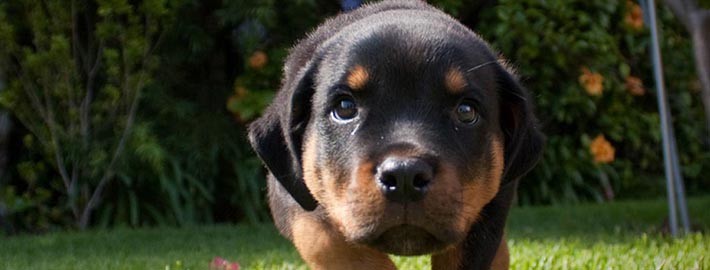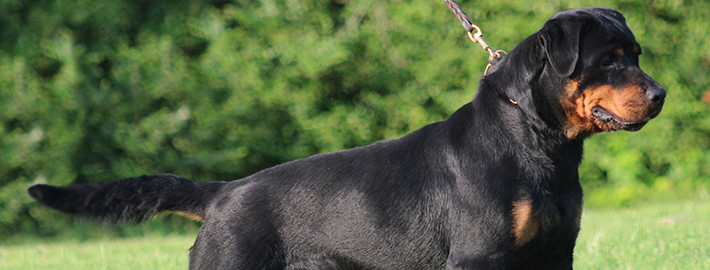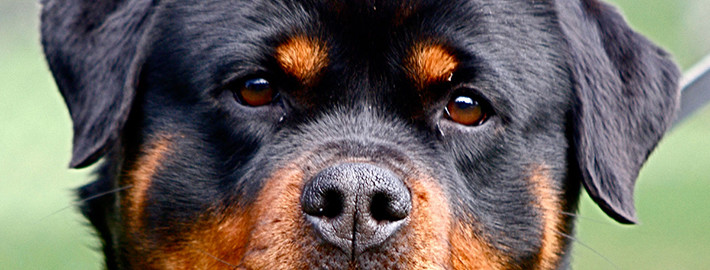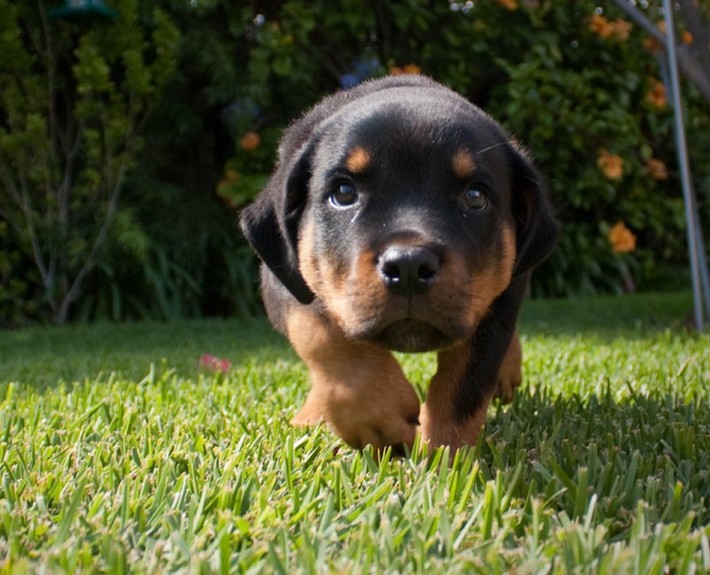What makes the Rottweiler Unique?
Descended from Roman guardian breeds, it is no surprise that the modern Rottweiler makes an effective police dog in various countries throughout the world. However, these dogs continue to be among the most popular canine breeds currently recognized by the American Kennel Club and they remain popular as family pets.
Breed Groups
Page Contents
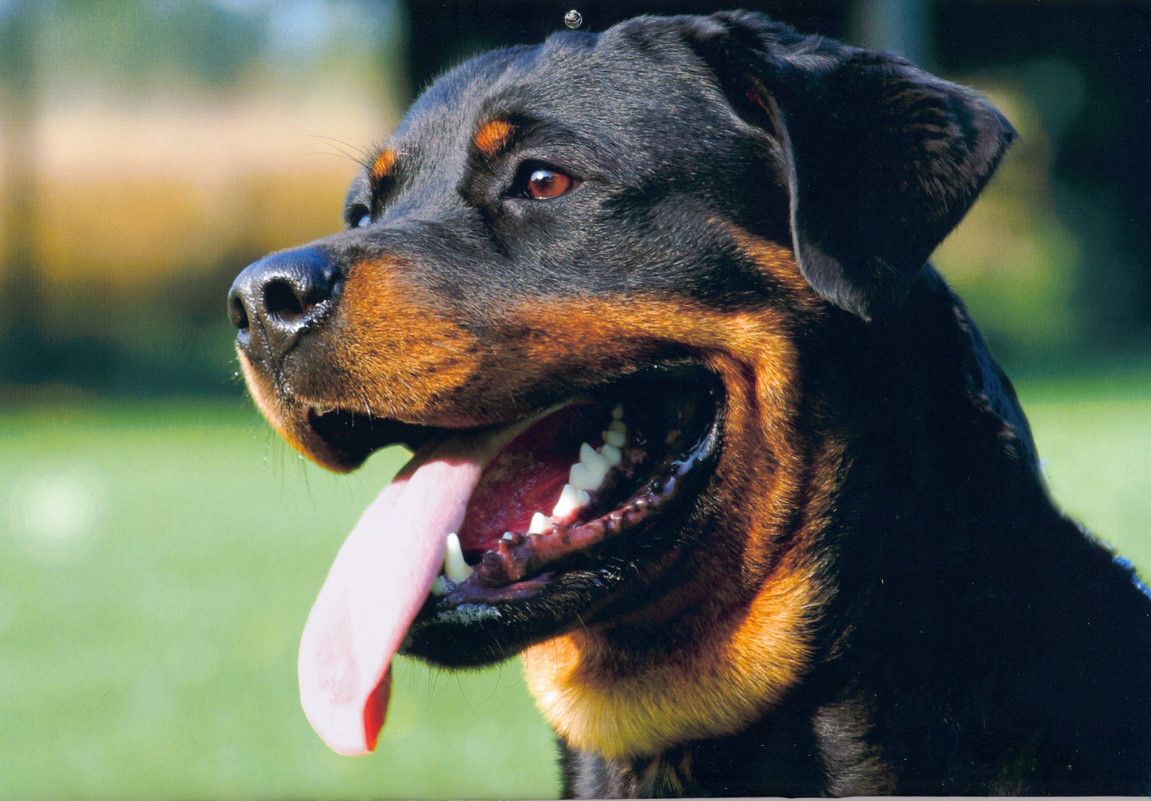
Is the Rottweiler Right For You?
Despite the occasionally unflattering media portrayal of the breed, properly raised Rottweilers can be incredibly devoted family members. Some may attempt to herd children in their custody by bumping into them. While this undesirable behavior can easily be trained out of the dogs, it does make the breed a bit of an accident hazard in households with small children. Rottweilers nonetheless make superb watchdogs and estate guardians. Even when officially introduced to strangers, these dogs maintain their distance. It takes some time for members of this breed to become comfortable with new people. Most Rottweilers would do anything to protect their families from what they perceive as a threat so owners will definitely need to make sure these dogs can recognize the difference to avoid problems from arising.
In 5 Words
- Devoted
- Steady
- Obedient
- Self-assured
- Good- natured
Characteristics
Learn About the Rottweiler
Description
General Description
Rottweilers are sturdy dogs with athletic builds. Members of this breed are somewhat longer than they are tall. American Kennel Club breed standards state that male Rottweilers should be “more massive throughout, with larger frame and heavier bone.” The same document goes on to add that female dogs should be “distinctively feminine” in appearance but without looking dainty. As they were originally bred to herd cattle over long distances, Rottweilers of both genders have a great deal of stamina. These dogs were similarly developed to be strong and agile so that they could easily protect livestock from predators. Rottweilers possess wide heads, round foreheads, well-developed muzzles, broad chests, and triangular ears. A scissors bite is typical for members of this breed. These dogs also have black lips and noses. The breed standard calls for Rottweilers to have an alert expression in their dark, almond shaped eyes. However, some individuals may nonetheless have blue or bicolored eyes. In places where the practice is not illegal, members of this breed typically have their tails docked. The dewclaws on their hind legs may likewise be removed.
Size
Male Rottweilers are slightly larger than their female contemporaries. On average, male dogs weigh between 110 and 132 pounds (50 and 60 kilograms). They stand approximately 24 to 27 inches (61 to 69 centimeters) tall. By comparison, female dogs typically stand 22 to 25 inches (56 to 63 centimeters) in height and they can weigh from 77 to 105 pounds (35 to 48 kilograms).
Coat
Rottweilers possess thick double coats that are coarse in texture and hang straight on their bodies. While the dogs are predominantly black, they also have markings at various points which may be rust, mahogany, or tan in hue. Due to a genetic problem that exists in some members of the breed, Rottweilers may also have red coats with brown markings.
Short History of the Rottweiler
Once the Roman Empire conquered what is now southern Germany and resettled the area, they brought their cattle dogs along with them. It is thought that these individual dogs, which were used to guard property and manage livestock, were the forerunners of the modern day Rottweiler breed. Despite their diverse functions, these dogs were chiefly used by butchers and ranchers who valued the breed’s ability to handle the cattle in question and protect them at the same time. When the railroads became prevalent and cattle driving was outlawed, Rottweilers decreased in popularity because they were no longer needed to get cows to market. Prior to the First World War, the breed’s fortunes changed again as they became popular as police dogs. Thanks to their war service in a number of useful fields, the breed eventually migrated to Great Britain and the United States. Rottweilers were officially recognized by the American Kennel Club as part of their working group in 1931.
Temperament
Despite the occasionally unflattering media portrayal of the breed, properly raised Rottweilers can be incredibly devoted family members. Among people they know, these dogs are quite cuddly and playful. Some may attempt to herd children in their custody by bumping into them. While this undesirable behavior can easily be trained out of the dogs, it does make the breed a bit of an accident hazard in households with small children. Rottweilers nonetheless make superb watchdogs and estate guardians. Even when officially introduced to strangers, these dogs maintain their distance. It takes some time for members of this breed to become comfortable with new people. Most Rottweilers would do anything to protect their families from what they perceive as a threat so owners will definitely need to make sure these dogs can recognize the difference to avoid problems from arising.
Caring for Your Rottweiler
General Health
A lifespan of 8 to 11 years is common for this breed. Rottweilers are especially prone to serious ailments such as dysplasia, osteosarcoma, subaortic stenosis, gastric torsion, and hypothyroidism. Allergies and obesity can also be problematic for members this breed. Owners will need to be sure that their dogs get adequate exercise in order to keep them from becoming overweight. Rottweilers will do not do well in warm climates if they are expected to spend a lot of time outdoors. Other health issues that may occasionally arise include von Willebrand’s disease, various eye ailments, seizures, and panosteitis. Rottweilers should have regular joint, eye, and heart testing done so that health problem are spotted before they become major concerns.
Care
Daily
All dogs need exercise on a daily basis and Rottweilers are no exception. Members of this breed will need several 15 minute walks per day. Puppies should not be exercised as often as their older counterparts because doing so can cause the individuals in question to suffer injuries which can result in future health problems.
Weekly
A once weekly brushing is recommended for members of this breed. It is also important for owners to regularly clean their dog’s teeth clean using a canine toothbrush and a pet formulated toothpaste so that the animals in question maintain good oral health.
Monthly
All pets require flea, heartworm, and tick prevention medications to keep them healthy. These products are usually administered once a month.
Grooming & Bathing
These dogs only have to be bathed when they get dirty but owners that are using gentle shampoos can wash their pet as frequently as once per week if they so desire. Rottweilers will also need to have their toenails trimmed and their ears cleaned out on an as needed basis.
Exercise & Training
Due to their large size and stubborn dispositions, Rottweilers are not recommended for inexperienced pets owners. These dogs must have early socialization and obedience training to ensure that they become well-behaved members of society. Owners will need to establish that they are in charge early on to avoid any dominance issues from arising. Rules must be in place from the time these dogs are puppies so that they do not become unmanageable when they reach their adult height and weight. After all, these are large dogs that could easily knock over a small child during the course of play. Members of this breed benefit from a firm hand and consistent rules, but be sure that any instruction given is fair and constructive rather than mean spirited. After all, Rottweilers are quite smart and eager to please their owners, a fact which certainly helps training go smoothly. Many members of this breed are used for police work but these dogs are also great candidates for various dog sports such as agility and obedience competitions.

